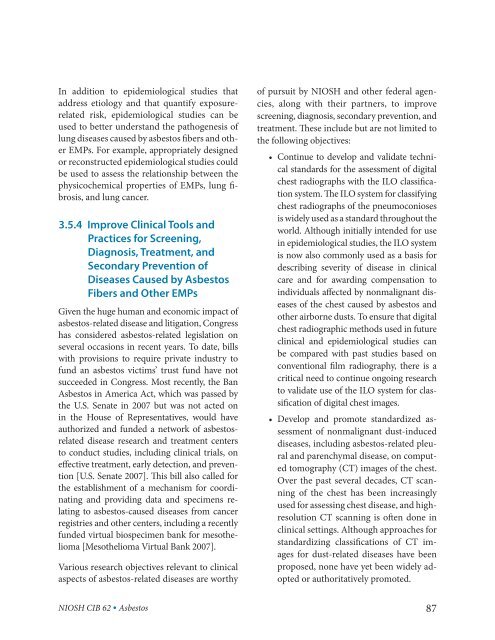Asbestos Fibers and Other Elongate Mineral Particles: State of the ...
Asbestos Fibers and Other Elongate Mineral Particles: State of the ...
Asbestos Fibers and Other Elongate Mineral Particles: State of the ...
- No tags were found...
Create successful ePaper yourself
Turn your PDF publications into a flip-book with our unique Google optimized e-Paper software.
In addition to epidemiological studies that<br />
address etiology <strong>and</strong> that quantify exposure-<br />
related risk, epidemiological studies can be<br />
used to better underst<strong>and</strong> <strong>the</strong> pathogenesis <strong>of</strong><br />
lung diseases caused by asbestos fibers <strong>and</strong> o<strong>the</strong>r<br />
EMPs. For example, appropriately designed<br />
or reconstructed epidemiological studies could<br />
be used to assess <strong>the</strong> relationship between <strong>the</strong><br />
physicochemical properties <strong>of</strong> EMPs, lung fibrosis,<br />
<strong>and</strong> lung cancer.<br />
3.5.4 Improve Clinical Tools <strong>and</strong><br />
Practices for Screening,<br />
Diagnosis, Treatment, <strong>and</strong><br />
Secondary Prevention <strong>of</strong><br />
Diseases Caused by <strong>Asbestos</strong><br />
<strong>Fibers</strong> <strong>and</strong> <strong>O<strong>the</strong>r</strong> EMPs<br />
Given <strong>the</strong> huge human <strong>and</strong> economic impact <strong>of</strong><br />
asbestos-related disease <strong>and</strong> litigation, Congress<br />
has considered asbestos-related legislation on<br />
several occasions in recent years. To date, bills<br />
with provisions to require private industry to<br />
fund an asbestos victims’ trust fund have not<br />
succeeded in Congress. Most recently, <strong>the</strong> Ban<br />
<strong>Asbestos</strong> in America Act, which was passed by<br />
<strong>the</strong> U.S. Senate in 2007 but was not acted on<br />
in <strong>the</strong> House <strong>of</strong> Representatives, would have<br />
authorized <strong>and</strong> funded a network <strong>of</strong> asbestosrelated<br />
disease research <strong>and</strong> treatment centers<br />
to conduct studies, including clinical trials, on<br />
effective treatment, early detection, <strong>and</strong> prevention<br />
[U.S. Senate 2007]. This bill also called for<br />
<strong>the</strong> establishment <strong>of</strong> a mechanism for coordinating<br />
<strong>and</strong> providing data <strong>and</strong> specimens relating<br />
to asbestos-caused diseases from cancer<br />
registries <strong>and</strong> o<strong>the</strong>r centers, including a recently<br />
funded virtual biospecimen bank for meso<strong>the</strong>lioma<br />
[Meso<strong>the</strong>lioma Virtual Bank 2007].<br />
Various research objectives relevant to clinical<br />
aspects <strong>of</strong> asbestos-related diseases are worthy<br />
NIOSH CIB 62 • <strong>Asbestos</strong><br />
<strong>of</strong> pursuit by NIOSH <strong>and</strong> o<strong>the</strong>r federal agencies,<br />
along with <strong>the</strong>ir partners, to improve<br />
screening, diagnosis, secondary prevention, <strong>and</strong><br />
treatment. These include but are not limited to<br />
<strong>the</strong> following objectives:<br />
• Continue to develop <strong>and</strong> validate technical<br />
st<strong>and</strong>ards for <strong>the</strong> assessment <strong>of</strong> digital<br />
chest radiographs with <strong>the</strong> ILO classification<br />
system. The ILO system for classifying<br />
chest radiographs <strong>of</strong> <strong>the</strong> pneumoconioses<br />
is widely used as a st<strong>and</strong>ard throughout <strong>the</strong><br />
world. Although initially intended for use<br />
in epidemiological studies, <strong>the</strong> ILO system<br />
is now also commonly used as a basis for<br />
describing severity <strong>of</strong> disease in clinical<br />
care <strong>and</strong> for awarding compensation to<br />
individuals affected by nonmalignant diseases<br />
<strong>of</strong> <strong>the</strong> chest caused by asbestos <strong>and</strong><br />
o<strong>the</strong>r airborne dusts. To ensure that digital<br />
chest radiographic methods used in future<br />
clinical <strong>and</strong> epidemiological studies can<br />
be compared with past studies based on<br />
conventional film radiography, <strong>the</strong>re is a<br />
critical need to continue ongoing research<br />
to validate use <strong>of</strong> <strong>the</strong> ILO system for classification<br />
<strong>of</strong> digital chest images.<br />
• Develop <strong>and</strong> promote st<strong>and</strong>ardized assessment<br />
<strong>of</strong> nonmalignant dust-induced<br />
diseases, including asbestos-related pleural<br />
<strong>and</strong> parenchymal disease, on computed<br />
tomography (CT) images <strong>of</strong> <strong>the</strong> chest.<br />
Over <strong>the</strong> past several decades, CT scanning<br />
<strong>of</strong> <strong>the</strong> chest has been increasingly<br />
used for assessing chest disease, <strong>and</strong> highresolution<br />
CT scanning is <strong>of</strong>ten done in<br />
clinical settings. Although approaches for<br />
st<strong>and</strong>ardizing classifications <strong>of</strong> CT images<br />
for dust-related diseases have been<br />
proposed, none have yet been widely adopted<br />
or authoritatively promoted.<br />
87

















